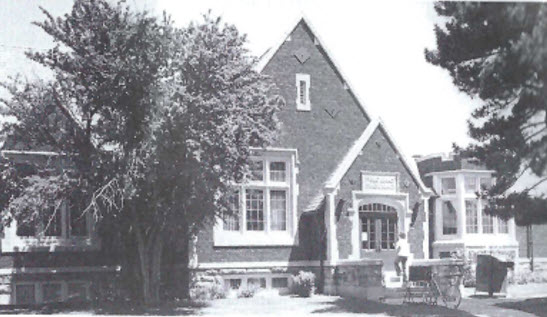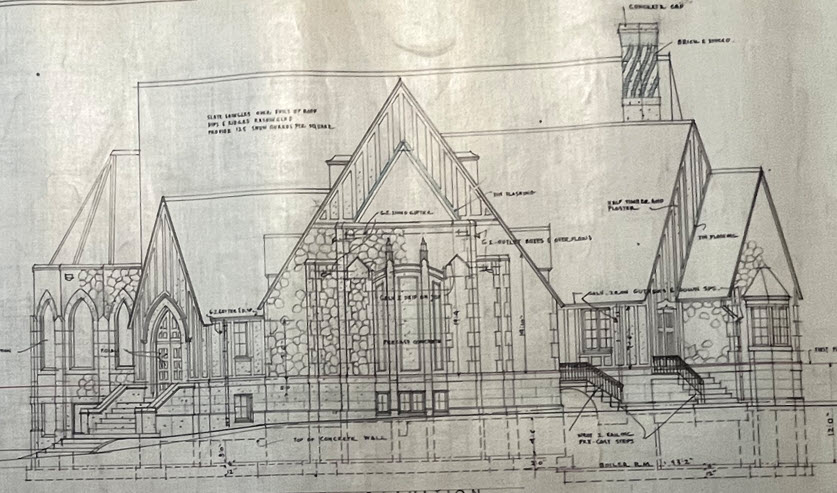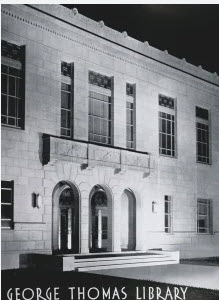Classical
Greek Revival
Greek Revival buildings can be recognized by decorative elements associated with monumental Greek architecture, such as columns, full and often exaggerated entablature, and pedimented gables and window heads.
Characteristics:
- symmetrical principal façade
- pedimented porch roof
- entablature (frieze, cornice)
- columns, usually of the Ionic, Doric, or Corinthian order
Neoclassical
The Neoclassical style uses Greek and Roman classical motifs, especially the orders (Doric, Ionic, Corinthian, Composite, and Tuscan), in a more conservative manner than do buildings of French Norman (or Beaux Arts) style classicism. Neoclassical buildings are symmetrical, monumental forms with facades highlighted by colonnades or large pedimented porticos that are integral to the design of the building. In Utah, banks, courthouses, post offices, and churches from 1900 - 1925 were often designed in this style.
Characteristics
- uninterrupted cornice and /or pedimented porticos
- smooth finish on masonry buildings
- symmetrical façade
- raised basement story
- terra cotta details
Early Twentieth Century
Prairie School
Prairie School designs create clean, precise, angular forms and emphasize horizontality. Masonry or stucco walls contribute to a spare appearance. Details such as wood or cast stone banding often accentuate the texture of the materials. Leaded or stained-glass windows contribute abstract patterns. The Prairie School style was particularly popular in Utah from 1905 – 1925 for residences and for LDS Church meetinghouses. Residential designs included one-story, narrow, masonry bungalows, well-suited to narrow city lots, and larger, symmetrical, two-story houses, nearly square or rectangular in form.
Characteristics
- brick masonry, stucco over masonry, or stucco over wood frame construction
- single-story porch or porte cochere projecting from the house
- low, hipped roof with wide, overhanging eaves
- horizontal bands of cast stone or concrete coping
- casement windows with geometric patterns created in stained and/or leaded glass
Modern Styles
Art Deco
The Art deco style was most popular in the US from 1930 – 1940. The style relies upon stylized plant and animal motifs as well as hard-lined, angular geometric patterning. Decorative parapets, echoing the effect of crenellation, surround flat-roofed buildings. Ornamentation consists of contrasting materials such as terra-cotta, colored glass, glass block, and various exposed metals. Large-scale monumental buildings often contain central towers.
Characteristics:
- angular geometric decorative patterns
- tower suggestive of high-rise buildings
- decorative parapet and cornice
- polychromatic decorative glass or glazed brick
Art Moderne
The Art Moderne (also known as “Streamline Modern”) style was influenced by the International Style and the work of industrial designers. It rejects all references to historicism. Flat-roofed Art Moderne buildings recall the machine aesthetic, nautical imagery, and especially the aerodynamic imagery of the locomotive and the airplane.
Characteristics:
–asymmetrical plan and horizontal volume
–curves including rounded corners, curved windows, or smooth wall surfaces
–flat roofs without cornices or eaves
–machine-age materials including steel pipe railings, aluminum and stainless steel, and glass block
California Modernism
California (Bay Area or Rustic) Modernism arose in the 1930s when a group of architects and landscape architects combined Modernism ideas with inspirations from Bay Area landscapes. Often viewed as a unique contrast to the International Style Modernism, their philosophy adopts basic geometric forms and makes liberal use of natural materials.
PWA Moderne
The Public Works Administration (PWA) was established in 1933 to loan money to states and municipalities for public projects. Many of these projects used the PWA Moderne style: a stripped-down Classicism with incorporation of Art Deco decorative motifs. These formal, symmetrical buildings with Art Deco details give them an updated appearance.
Characteristics:
- smooth wall surfaces, flat roof and plain, narrow cornices
- symmetrical façade
- vertical molded ornamentation and Art Deco decorative motifs
Period Revival
Colonial Revival
The Colonial Revival style was an effort to look back to the Federal and Georgian architecture of America's founding period for design inspiration. Generally, the Colonial Revival style included front façade symmetry, front entrance fanlights and sidelights, gable roofs, and pedimented doorways. The style was popular for homes, but also for public buildings including government offices, post offices, libraries, banks, schools and churches.
Dutch Colonial Revival
Dutch Colonial Revival homes usually have a gambrel roof where one (or both) of the lower slopes flares at the eaves in a gentle curve. They may have Dutch tiles around the fireplace or shutters with decorative holes, but otherwise are similar to Colonial Revival homes with a symetric front facade.
English Cottage
English Cottage style homes are typically small one-and-one-half-story, all brick residences, primarily constructed after World War I by speculative builders on small suburban lots. Picturesque irregular massing, a variety of window shapes, and the decorative use of materials combined to make these small but affordable houses popular.
Characteristics:
- brick and stone masonry in a textured pattern
- asymmetrical façade and steeply pitched gable roof
- round or segmental arch openings"
French Norman Revival
French medieval architecture was brought to the US in the late 19th century by Ecole des Beaux Arts-educated Richard Morris Hunt. The French Norman Revival was the second wave of enthusiasm for French architecture in the US (1915 – 1935 in Utah). It was loosely based upon the vernacular architecture of Normandy and Brittany. We know that Ray Ashton was educated at the Chicago-based Ecole des Beaux Arts, so their occasional use of French Norman Revival style is not unexpected.
Stone and brick were the common building materials, and both square and round towers were incorporated into designs in the US, often in combination with stucco wall surfaces, half-timbering, and decorative brick patterns. Steeply pitched roofs were also common.
Characteristics
- square, round, or octagonal towers with conical or pyramidal roofs
- steeply pitched gable and hip roofs
- terra-cotta window and door surrounds
- brick and/or stone masonry walls
- wall dormers
Jacobethan Revival
This conglomerate term comes from joining the English historical designations Jacobean and Elizabethan. These designs using borrow motifs from both phases of the English Renaissance. Distinctive gables, windows, and chimneys emphasize the forms. The outer walls are often composed of brick combined with stone—or terra-cotta imitating stone—in the form of quoins, cornices, parapets, and door-and-window surrounds.
Characteristics:
–steeply piteched gable roof
–bay windows
–crenellated parapets
–stone or terra-cotta window and door surrounds
Moorish Revival
One of the most distinctive elements of Moorish Revival architecture is the horseshoe arch: an arch that bulges outwards from the base, forming a curve that looks like a horseshoe. Moorish arches often contain decorative elements. This style often also includes circular or onion-shaped domes (topped with a pointed spire), a fair amount of color, and of ornate design and ornamentation in the domes, arches, windows, doorways, and eaves.
Pueblo Revival
Derived from Native American pueblo architecture, this style was more popular in other parts of the West than in Utah. Examples of the style have battered walls emulating thick adobe walls, rounded corners, flat roofs (often with set-back upper stories like true pueblos), stucco walls, and roof rafters projecting from the outer walls.
Characteristics:
- battered stucco walls
- flat roofs with parapets
- stepped-back upper stories
Tudor Revival
Tudor styles refer to the timber-frame architecture of medieval England. Utah examples of Tudor Revival style imitated the timber’s visual effects. The style was popular in LDS church construction during the depression years (1929-36) promoted by Englishman Arthur Price who led the LDS church building program during that time. The style was also very popular in residential construction since the homes were usually small and affordable.
Characteristics:
- picturesque irregular massing and an asymmetrical facade
- exposed framing members
- brick and stone masonry in a textured pattern
Spanish Colonial Revival
Based upon the baroque architecture of Mexico, the Spanish Colonial Revival style is characterized by red tile roofs and white stucco-covered wall surfaces. The style was used for schools, churches, residences, apartment buildings, and commercial buildings. Low-relief ornament, decorative cornices and parapets, and wrought iron grills and balconies differentiate this style.
Characteristics:
- red tile roofs and white stucco wall surface
- low-relief ornamentation
- wrought iron balconies
- decorative door surrounds of tile or terra-cotta
Picturesque
Gothic Revival
| The Gothic Revival style is part of the mid-19th century picturesque movement in architecture, reflecting the public's taste for buildings inspired by medieval design. These buildings are vertically oriented with pointed arches, steeply pitched roofs, and often with elaborate saw-cut ornament.
Characteristics:
|
Post-War Styles
New Formalism
By the 1950s, the International Style of Modernism had matured. The concepts of classicism began to creep back into architecture as classical order, geometry in form, and a uniform grid were emphasized. Besides the theoretical aspects, architects implemented traditional materials, including marble, granite, and travertine. The design concepts of New Formalism were also applied to urban planning in the use of grand axes and symmetry to achieve monumentality.
Characteristics:
- monumental in size
- implied classical architectural elements (columns, colonnades, podiums)
- geometrical order and symmetry
Post-War Modern
Prior to World War II (1930 – 1940), the modern styles (Art Deco, Art Moderne, International, etc.) using glass and steel were a major influence on Utah architecture – in both commercial and upscale residential buildings. Following the war (1946 – 1960), that influence continued, supplemented by advances in construction and finish materials. The building boom that followed WWII kept the boxiness and openness of pre-war structures, but added new materials brought about by technological advances in concrete, aluminum, synthetics, and, of course, glass. Residential structures became pared down rather than having historic-based details.
Characteristics:
- boxy or planar in appearance, with occasional curves or sharp angles.
- no architectural ornamentation
- large glazed areas or bands of glazing
- increased use of glass and aluminum
Victorian
Second Renaissance Revival
Formally trained architects brought the Second Renaissance Revival style to Utah. It was commonly used in institutional architecture: libraries, university buildings, and private mens’ clubs. The Second Renaissance Revival interprets the Classical Style by reusing motifs generated during the Italian Renaissance. This style relies on a large scale and imparts simplicity and order with two-dimensional decoration.
Characteristics:
- symmetrical facade
- masonry construction
- wide, overhanging cornices with ornamental brackets underneath



![PS Ste. Revelle Development [unbuilt], 1913, Woolley & Ashton.](https://ashtonandevans.com/wp-content/uploads/2024/07/PS.jpg)







![FN Abbey of our Lady of the Holy Trinity [unbuilt], 1952, AEB.](https://ashtonandevans.com/wp-content/uploads/2024/07/FN.jpg)








